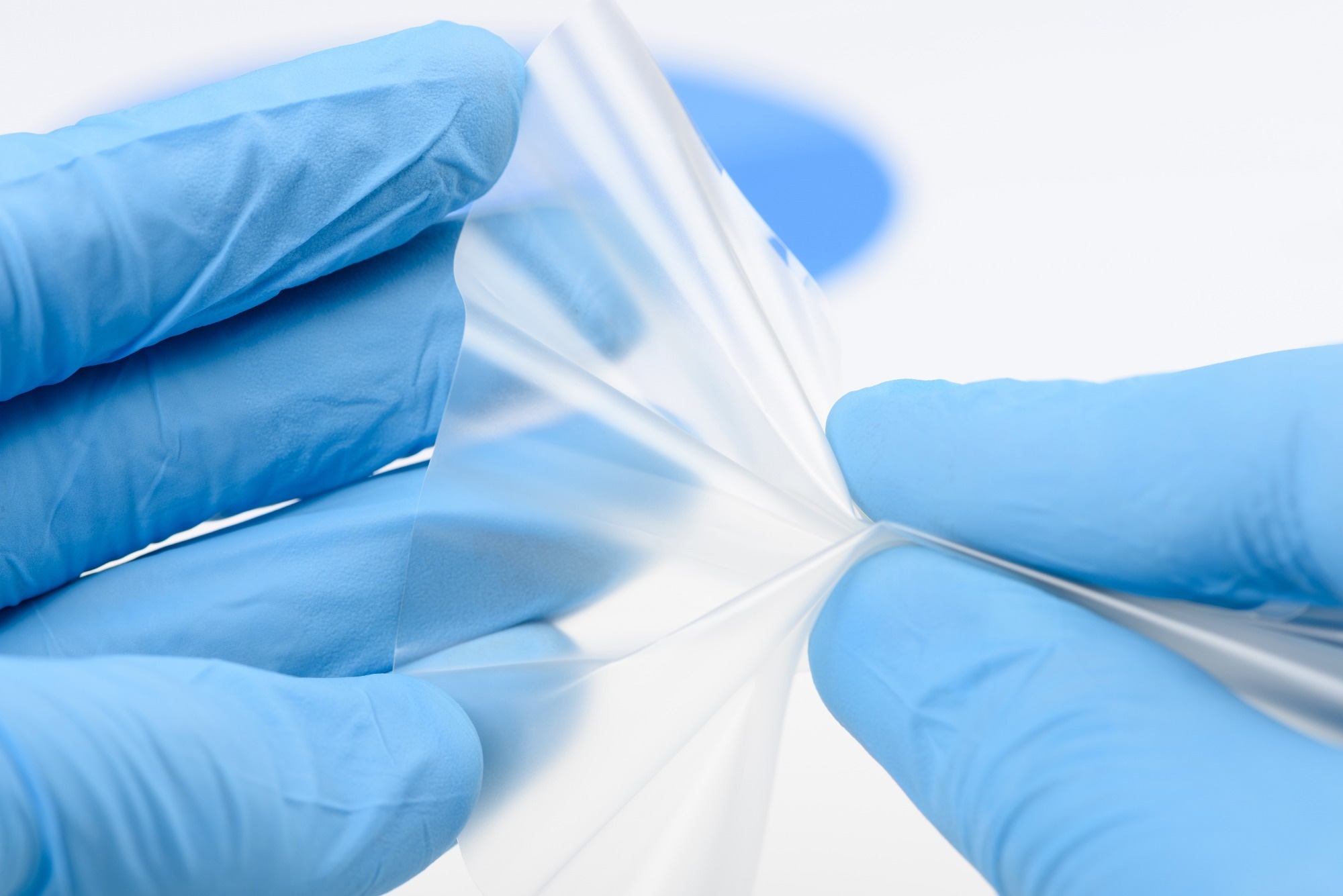Researchers have discovered that the primary cause of surface wrinkling in plasma-oxidized PDMS films is water vapor absorption, not thermal cycling as previously believed. This finding is significant in developing reversible optical sensors for humidity and temperature.

Image Credit: nevodka/Shutterstock.com
The study, published in Advanced Functional Materials, offers new insights into the mechanics of PDMS surfaces, opening up greater potential for its practical application in environmental monitoring and soft electronics.
Wrinkling Technology and Why It Matters
Soft lithography is a non-photolithographic method used to fabricate nano- and micro-patterns, without the need for expensive machinery.
One of the most effective fabrication methods in soft lithography is surface wrinkling, where periodic topographies are produced through compressive stress on a thin, stiff film attached to a softer substrate. These patterns span from nanometers to hundreds of micrometers and are tunable in both wavelength and amplitude.
PDMS elastomers are particularly popular substrate materials in soft lithography thanks to their optical clarity, mechanical flexibility, customizable surface chemistry, and strong adhesion.
The stiff outer "skin" needed for wrinkling is most commonly created by plasma oxidation onto the PDMS substrate. This process forms a thin, glass-like silica layer, which undergoes stress and deforms.
While earlier theories credited thermal cycling for this behavior, this study found that water vapor sorption was the primary factor in the wrinkled layer.
Unpacking the Role of Humidity
To understand the wrinkling process, the research team created a controlled atmosphere during and after plasma oxidation. They treated various PDMS films of different thicknesses, ranging from 100 nm to several tens of micrometers, with oxygen plasma across multiple gas environments, including nitrogen, argon, and ambient air.
They then analyzed the different PDMS films' surface topographies using atomic force microscopy (AFM) and small-angle light scattering (SALS).
The researchers found that, contrary to their expectations, wrinkling did not occur when the films were kept in inert gases like nitrogen or argon throughout the plasma oxidation process. However, wrinkles began to form once the films were exposed to air with any water vapor content.
Using a quartz crystal microbalance, the team found that oxidized PDMS absorbed up to 8 % of its mass in water, compared to just 0.5 % in untreated PDMS. This extra absorption caused swelling, leading to compressive stress and then wrinkling.
Additional tests with X-ray photoelectron spectroscopy and Fourier-transform infrared spectroscopy further confirmed the hypothesis that the water was absorbed into the oxidized layer without altering its chemical makeup.
When exposed to humid conditions, O-H stretching bands appeared in the PDMS film spectra, indicating the presence of water. Greater swelling was observed in the oxidized side of PDMS during bending tests, causing curvature that varied depending on film thickness.
Modeling the Mechanics
The researchers developed a “sorption-wrinkling” model linking moisture absorption with mechanical instability to develop their understanding of the effects of water vapor sorption.
They tracked how water uptake drives swelling using Fickian diffusion equations and how this, in turn, induces wrinkling. Linear stability analysis helped predict the relationship between swelling and wrinkle height.
They observed that wrinkle wavelength stayed consistent at around 2.1–2.3 µm across humidity levels, but wrinkle height increased with higher humidity. The time it took for wrinkles to appear varied hugely, from about 18 hours at 22 % relative humidity to under 12 minutes at 98 %. Their model accurately captured both the speed and scale of wrinkle formation.
The study's results stayed consistent with classical bilayer theory, showing that wrinkle wavelength depended on film thickness. Films thinner than ~200 nm didn’t wrinkle at all, while thicker ones occasionally developed cracks and wrinkles.
They found that it was possible to tune wrinkling by changing the relative humidity; cycling between dry and humid conditions caused reversible relaxation and formation of the wrinkle patterns.
Towards Practical Sensing Applications
This reversible wrinkling effect could be used to develop simple but effective optical sensing applications. The researchers explored this, showing that a wrinkled PDMS surface could act as a diffraction grating, producing color patterns under white light. When exposed to high humidity or low temperatures, vibrant diffracted colors emerged. In contrast, when exposed to dry conditions, the surface flattened, and the colors disappeared.
By selectively masking areas during plasma oxidation, the team created sensors with localized responses to humidity and temperature. These sensors are low-cost and easy to fabricate using soft lithographic methods, and they are well-suited for use in environmental monitoring, smart packaging, and wearable tech.
Looking Ahead
Water vapor absorption into the oxidized PDMS layer is the primary cause of observed wrinkling behavior. This finding offers a clearer, more reliable explanation of reversible wrinkling than previously suggested thermal-based models. This clarifies earlier inconsistencies and shows the potential of plasma-oxidized materials that can adapt to environmental changes in real time.
Future research could explore applications in flexible electronics, medical devices, and microfluidics, where controlling surface shape is essential. Tuning plasma settings or film thickness may also allow for customized wrinkle patterns tailored to light manipulation or fluid control.
Journal Reference
Ahmad, Z. et al. Surface Wrinkling of Plasma-Exposed PDMS is Caused by Water Vapor Sorption: An Optical Environmental Sensor. Advanced Functional Materials, 2025. DOI: 10.1002/adfm.202509167, https://advanced.onlinelibrary.wiley.com/doi/10.1002/adfm.202509167
Disclaimer: The views expressed here are those of the author expressed in their private capacity and do not necessarily represent the views of AZoM.com Limited T/A AZoNetwork the owner and operator of this website. This disclaimer forms part of the Terms and conditions of use of this website.